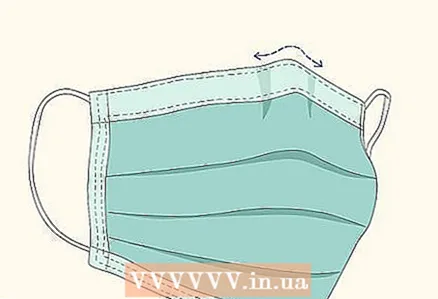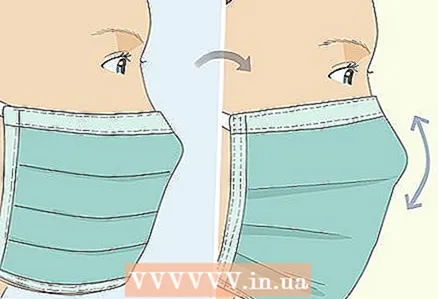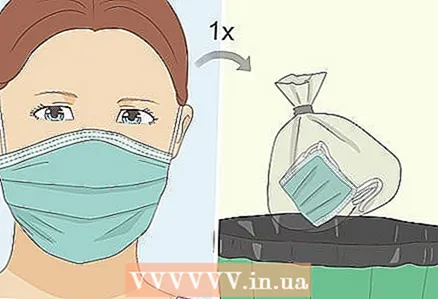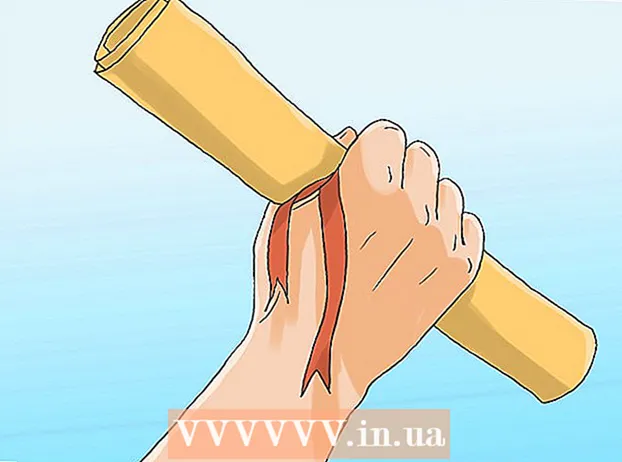
Content
- Steps
- Method 1 of 3: What is a disposable medical mask
- Method 2 of 3: How to put on a disposable medical mask
- Method 3 of 3: How to Remove a Disposable Medical Mask
- Tips
- Warnings
The disposable medical mask is one of the most widely used medical products.They are used mainly by healthcare workers to protect themselves and others from airborne infections, biological fluids and fine particles of moisture and dust scattered in the air. Often during outbreaks of epidemics of diseases transmitted by airborne droplets, health services recommend the population to use disposable masks. A properly worn mask should completely cover the mouth and nose without causing difficulty in breathing.
Steps
Method 1 of 3: What is a disposable medical mask
 1 It should be understood what the medical mask protects from. Medical masks cover the nose and mouth. They are made of material that does not pass through large drops and splashes, which may contain harmful viruses and bacteria.
1 It should be understood what the medical mask protects from. Medical masks cover the nose and mouth. They are made of material that does not pass through large drops and splashes, which may contain harmful viruses and bacteria. Keep in mind: small droplets can still penetrate the mask material. In addition, the edges of the mask do not adhere very tightly to the skin, so pathogens can penetrate underneath through small crevices along the edges.
 2 Be aware of the difference between a disposable medical mask and a medical respirator. Respirators are often used by health care workers and their filters trap about 95% of small droplets and particles. Unlike conventional medical masks, respirator masks adhere more tightly to the skin of the face and are able to filter out small airborne particles.
2 Be aware of the difference between a disposable medical mask and a medical respirator. Respirators are often used by health care workers and their filters trap about 95% of small droplets and particles. Unlike conventional medical masks, respirator masks adhere more tightly to the skin of the face and are able to filter out small airborne particles. - Although medical respirators trap about 95% of very small particles (0.3 micrometers and larger), 5% of the particles still penetrate them.
- Respirators are not intended for use by children or people with facial hair.
- Some respirators are supplied with exhalation valvewhich prevents moisture from accumulating inside the mask and makes breathing easier. However, such respirators should not be used where a sterile atmosphere is required, as unfiltered and possibly contaminated air is released through the exhalation valve.
- As a rule, all types of respirators are accompanied by detailed instructions from the manufacturer, which describe how to properly put on and take off the mask. In order to protect yourself and your patients, these instructions must be strictly followed. Health care workers are trained in how to properly use respirators.
Method 2 of 3: How to put on a disposable medical mask
 1 Wash your hands. Before picking up the mask, wash your hands thoroughly with soap and water.
1 Wash your hands. Before picking up the mask, wash your hands thoroughly with soap and water. - Wet your hands with water and lather for at least 20 seconds, then wash off the lather.
- After washing your hands, dry them with a clean paper towel, then discard the used towel in the trash can.
Advice: Before you discard the paper towel, you can use it to open the bathroom or toilet door to avoid touching the handle with clean hands.
 2 Check if the mask is damaged. After removing a new (unused) medical mask from the package, check that it is intact and for holes, tears or other defects. If the mask is damaged or contains any defects, discard it and remove another mask from the pack.
2 Check if the mask is damaged. After removing a new (unused) medical mask from the package, check that it is intact and for holes, tears or other defects. If the mask is damaged or contains any defects, discard it and remove another mask from the pack.  3 Find the top edge of the mask. In order for the medical mask to fit snugly to the skin of the face, its upper edge is equipped with a flexible elastic insert, which, when the mask is put on, tightly covers the nose. Before putting on the mask, take it so that this insert is on top.
3 Find the top edge of the mask. In order for the medical mask to fit snugly to the skin of the face, its upper edge is equipped with a flexible elastic insert, which, when the mask is put on, tightly covers the nose. Before putting on the mask, take it so that this insert is on top.  4 Determine the inside and outside of the mask. Most disposable medical masks have a white inner surface, while their outer side is painted in some color. Take the inside of the mask towards you before putting it on.
4 Determine the inside and outside of the mask. Most disposable medical masks have a white inner surface, while their outer side is painted in some color. Take the inside of the mask towards you before putting it on.  5 Put the mask on your face. There are different types of disposable medical masks, which differ in the way they are attached to the head.
5 Put the mask on your face. There are different types of disposable medical masks, which differ in the way they are attached to the head. - Ear loops... This mask has two ear loops, one at each end. Usually these loops are made of elastic material and can be stretched. Take the mask by the loops and thread each one behind the corresponding ear.
- Strings... Along the edges of such a mask there are ribbons that are tied around the head. Most masks have two ties at each end, one at the bottom and one at the top. Grasp the top straps, place them behind your head, and tie them together.
- Rubber bands... These masks have two elastic bands that wrap around the head just above and below the ears. Bring the mask to your face and place the top elastic over your head, placing it over your ears. Then, slide the bottom elastic behind your head, securing it at the base of the skull.
 6 Correct the mask on the nose. After attaching the disposable mask to your face, grasp its upper elastic edge with your index and thumb and bend it so that it fits snugly around the bridge of your nose.
6 Correct the mask on the nose. After attaching the disposable mask to your face, grasp its upper elastic edge with your index and thumb and bend it so that it fits snugly around the bridge of your nose.  7 Tie bottom straps if necessary. If you are using a mask that has top and bottom strings, pull the bottom straps back and tie them at the base of the skull. It is best to do this after you have correctly positioned the top edge of the mask on the bridge of your nose.
7 Tie bottom straps if necessary. If you are using a mask that has top and bottom strings, pull the bottom straps back and tie them at the base of the skull. It is best to do this after you have correctly positioned the top edge of the mask on the bridge of your nose. - If you have tied the bottom straps before, you may need to loosen them and re-tie them around your head.
 8 Spread the mask over your face and under your chin. After securing the mask properly, straighten it so that it covers the lower half of the face and mouth, and its lower edge is under the chin. SPECIALIST'S ADVICE
8 Spread the mask over your face and under your chin. After securing the mask properly, straighten it so that it covers the lower half of the face and mouth, and its lower edge is under the chin. SPECIALIST'S ADVICE 
World Health Organization
Global Health Agency The World Health Organization (WHO) is the United Nations specialized agency for international health. Founded in 1948, WHO monitors health risks, promotes health promotion and prevention, and coordinates international health cooperation and emergency response. WHO is currently leading and coordinating worldwide efforts to address the COVID-19 pandemic, helping countries prevent and detect disease and take action. World Health Organization
World Health Organization
Global Health AgencyExperts warn: Masks are only effective when combined with frequent hand cleansing with alcohol-based hand rub or washing with soap and water.
Method 3 of 3: How to Remove a Disposable Medical Mask
 1 Clean your hands. Depending on what you have been doing before, you may need to wash your hands or remove medical gloves.
1 Clean your hands. Depending on what you have been doing before, you may need to wash your hands or remove medical gloves.  2 Remove the mask carefully. When removing the mask, you should only touch its edges, strings, elastic bands or loops. Avoid touching the outside of the mask, which may be dirty.
2 Remove the mask carefully. When removing the mask, you should only touch its edges, strings, elastic bands or loops. Avoid touching the outside of the mask, which may be dirty. - Ear loops... Hook the loops with your fingers and pull them out from behind the ears.
- Ties / ribbons... Untie the bottom ties first, then undo the top ties. Remove the mask by holding the top ties.
- Rubber bands... Grasp the bottom elastic and pull it upward, removing it from your head. Then do the same for the top elastic. Remove the mask by holding the top elastic.
 3 Throw away the mask. Disposable medical masks are not intended for reuse. After removing the mask, discard it immediately in the trash can.
3 Throw away the mask. Disposable medical masks are not intended for reuse. After removing the mask, discard it immediately in the trash can. - Health care facilities usually have bins specifically for biohazardous waste such as used masks and gloves.
- If you are in a public area that is not equipped with a biohazard collection container, put the used mask in a plastic bag. Tie the bag up and then throw it into a regular waste bin.
 4 Wash your hands again. After removing the mask and discarding it, wash your hands to help remove germs and other contaminants from your skin that may have gotten onto your skin when in contact with the used mask.
4 Wash your hands again. After removing the mask and discarding it, wash your hands to help remove germs and other contaminants from your skin that may have gotten onto your skin when in contact with the used mask.
Tips
- Various types of medical masks and respirators can be found on the Internet, on the websites of their manufacturers, as well as on the website of the Centers for Disease Control and Prevention (USA) at http://www.cdc.gov/niosh/npptl/topics/respirators/ disp_part / respsource3healthcare.html. This site contains photographs of various types of medical masks and respirators and their comparative characteristics.
- Always try to use soap and water to disinfect your hands. However, if you are unable to do this, you can use a hand sanitizer containing not less 60% alcohol.Apply to hands enough to keep the skin moist for at least 10 seconds after spreading it over the hands.
Warnings
- In the context of a shortage of disposable medical masks and medical respirators, they should not be bought. They are more needed by health-care workers and those who are sick or caring for the sick; the rest can use reusable cloth masks.
- Disposable medical masks are intended for one-time use by one person. Throw away the used mask and never re-wear it.
- There are many types of protective masks that are not intended for medical purposes. Typically, these masks can be found at hardware stores. They serve to protect the mouth and nose of people working with wood, metal and other types of construction materials from dust. These masks do not meet the requirements for medical masks.



